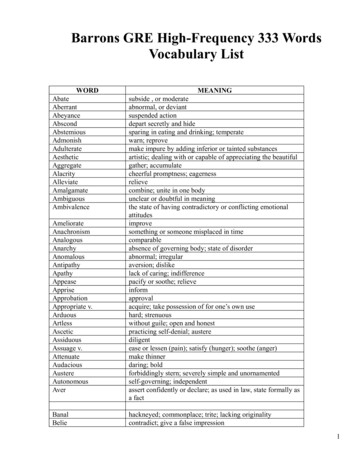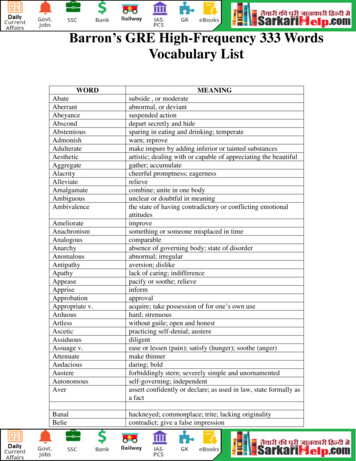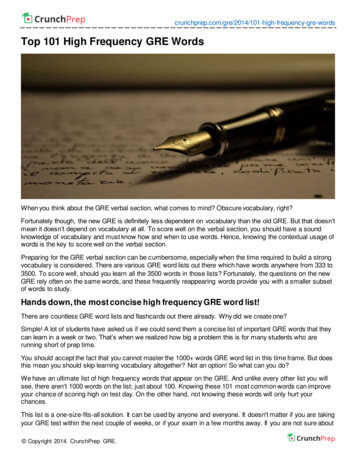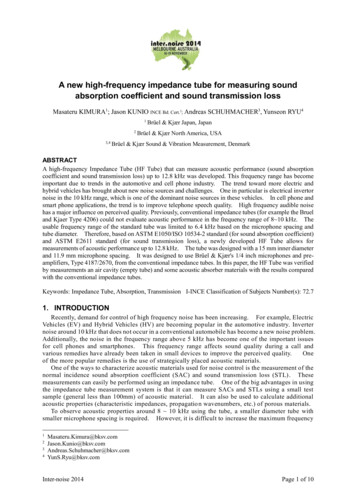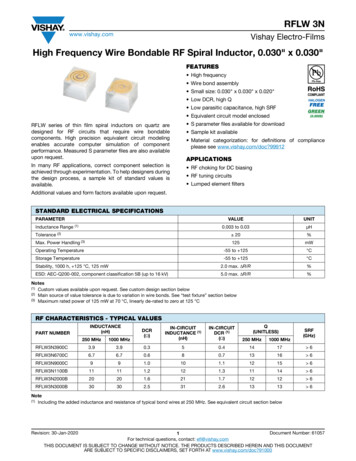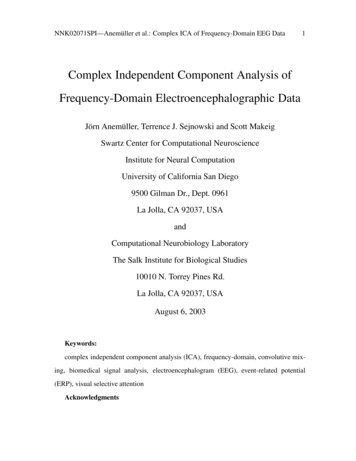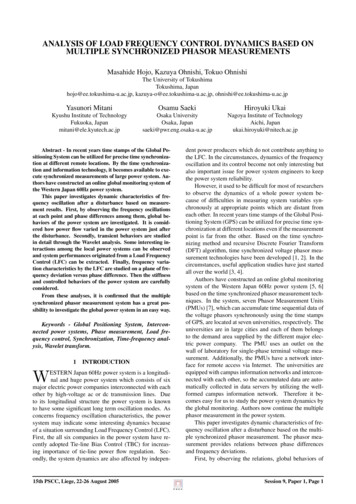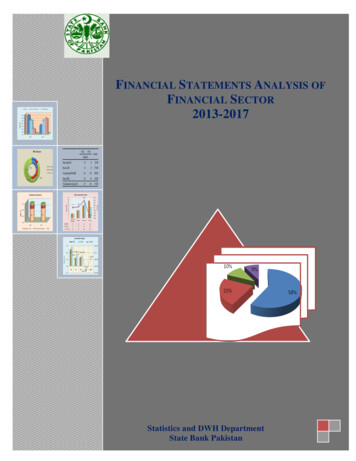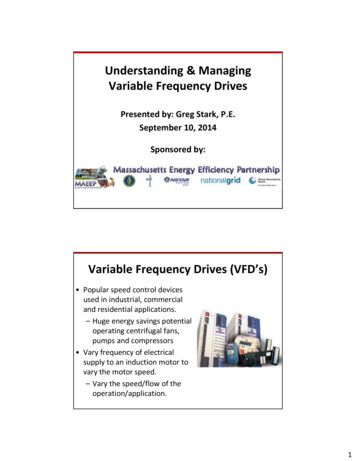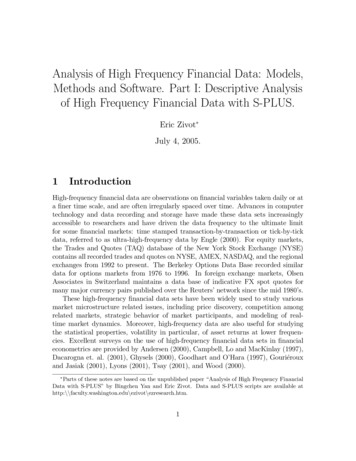
Transcription
Analysis of High Frequency Financial Data: Models,Methods and Software. Part I: Descriptive Analysisof High Frequency Financial Data with S-PLUS.Eric Zivot July 4, 2005.1IntroductionHigh-frequency financial data are observations on financial variables taken daily or ata finer time scale, and are often irregularly spaced over time. Advances in computertechnology and data recording and storage have made these data sets increasinglyaccessible to researchers and have driven the data frequency to the ultimate limitfor some financial markets: time stamped transaction-by-transaction or tick-by-tickdata, referred to as ultra-high-frequency data by Engle (2000). For equity markets,the Trades and Quotes (TAQ) database of the New York Stock Exchange (NYSE)contains all recorded trades and quotes on NYSE, AMEX, NASDAQ, and the regionalexchanges from 1992 to present. The Berkeley Options Data Base recorded similardata for options markets from 1976 to 1996. In foreign exchange markets, OlsenAssociates in Switzerland maintains a data base of indicative FX spot quotes formany major currency pairs published over the Reuters’ network since the mid 1980’s.These high-frequency financial data sets have been widely used to study variousmarket microstructure related issues, including price discovery, competition amongrelated markets, strategic behavior of market participants, and modeling of realtime market dynamics. Moreover, high-frequency data are also useful for studyingthe statistical properties, volatility in particular, of asset returns at lower frequencies. Excellent surveys on the use of high-frequency financial data sets in financialeconometrics are provided by Andersen (2000), Campbell, Lo and MacKinlay (1997),Dacarogna et. al. (2001), Ghysels (2000), Goodhart and O’Hara (1997), Gouriérouxand Jasiak (2001), Lyons (2001), Tsay (2001), and Wood (2000). Parts of these notes are based on the unpublished paper “Analysis of High Frequency FinancialData with S-PLUS” by Bingchen Yan and Eric Zivot. Data and S-PLUS scripts are available htm.1
High-frequency financial data possess unique features absent in data measured atlower frequencies, and analysis of these data poses interesting and unique challengesto econometric modeling and statistical analysis. First, the number of observations inhigh-frequency data sets can be overwhelming. The average daily number of quotes inthe USD/EUR spot market could easily exceed 20,000, and the average daily numberof observations of an actively traded NYSE stock can be even higher. Second, dataare often recorded with errors and need to be cleaned and corrected prior to directanalysis. For various reasons, high-frequency data may contain erroneous observations, data gaps and even disordered sequences. Third, transaction-by-transactiondata on trades and quotes are, by nature, irregularly spaced time series with randomdaily numbers of observations. Moreover, trades and quotes on multiple assets seldomoccur at the same time, and trading activity varies considerably across assets. Fourth,high-frequency data typically exhibit periodic (intra-day and intra-week) patterns inmarket activity. It is well known that trading activities at the NYSE are more densein the beginning and closing of the trading day than in the lunch hours. FX trading activities also systematically vary as the earth sequentially passes through thebusiness hours of geographical trading centers. Furthermore, discrete price movements, nonsynchronous trading, and bid-ask bounce may distort inferences based onstandard statistical models.The above characteristics of high frequency financial data substantially complicatethe process of econometric and statistical analysis, and typical statistics and econometrics software do not contain the tools necessary to properly handle and analyzehigh frequency data. S-PLUS, with its rich and flexible object oriented statisticalmodeling language and graphical facilities, is ideally suited for the analysis of highfrequency data. This part of the lecture illustrates how to process and descriptivelyanalyze high-frequency financial data using the S-PLUS statistical modeling languageand the S FinMetrics module for the analysis of time series data. The goal are (1) toprovide a practical guide to high-frequency financial data analysis, from getting rawdata into the software program, to preparing data for analysis and creating relevantvariables, and to performing basic descriptive and graphical analysis; (2) to illustratethe basic characteristics of high frequency financial time series, and to motivate thestatistical modeling of high frequency data. Three example data sets are used todemonstrate the applications of techniques and tools discussed, two from equity markets (TAQ data) and one from FX markets (Olsen data). The lectures make use ofthe S-PLUS library HF developed by Bingchen Yan and Eric Zivot, which containsa collection of functions specially designed for high-frequency financial data analysis.The organization of the lecture is as follows. Section 1 gives a brief overview of theS-PLUS library HF. Section 3 introduces three example data sets and describes howto load and process the data for further analysis. Section 4 deals with basic data manipulations, such as creating various market variables, performing summary statistics,regularizing unequally spaced data. It also illustrates some empirical characteristicsof high-frequency data using basic descriptive statistics and graphical techniques.2
2Overview of the S-PLUS HF libraryThe S-PLUS HF library is a collection of S-PLUS functions written by Bingchen Yanand Eric Zivot1 . Table 1 gives a brief summary of the main functions in the library.The functions make use of the proprietary “timeDate” and “timeSeries” classes inS-PLUS, version 6.0 and higher, that can be used to characterize irregularly spaced,intra-day high frequency time series. Functions are included to load data from theTAQ and Olsen data, to perform data manipulation and descriptive analysis overspecified trading periods, and to construct variables frequently used in the analysisof high frequency time series.The following sections illustrate the descriptive analysis of high frequency financialtime series using S-PLUS and the functions in the HF library.3Data Processing3.1Data SetsThe data sets used in this lecture are trades and quotes data for Microsoft and GE(05/01/1997—05/15/1997) and USD/EUR spot rate quotes (03/11/2001—03/17/2001).The trades and quotes data for Microsoft are saved in the ASCII files“trade msft.txt”and “quote msft.txt”, while similar data for GE are saved in “trade ge.txt” and“quote ge .txt”. These data sets contain standard and complete information fromthe TAQ database2 . For example, the first six rows of trade msft.txt are:cond ex symbol corr g127 price siz tdate tseq ttim T T MSFT 0 0 121.125 1500 01MAY1997 0 28862 T T MSFT 0 0 121.5625 500 01MAY1997 0 28944 T T MSFT 0 0 121.5625 1000 01MAY1997 0 29000 T T MSFT 0 0 121.5625 1200 01MAY1997 0 29002 T T MSFT 0 0 121.625 1000 01MAY1997 0 31095 The trades data have 10 columns separated by “ ”. The most important columnsare “symbol” for stock symbol (e.g. “GE” or “MSFT”), “price” for transaction prices(e.g. 110.625), “size” for traded size in number of shares (e.g. 100), “tdate” for date ofthe trade (e.g. “01MAY1997”), and “ttime” for time of the trade in seconds since themidnight of the day (e.g. 34220). The time used in the TAQ database is recorded in1The library FH was developed by the authors and is available for download athttp:\\faculty.washington.edu\ezivot\splus.htm. The library was created using S-PLUS 6.2. Thelibrary is currently being updated to incorporate the big data features of S-PLUS 7.0. WolfgangBreymann also has an S-PLUS library of functions for the analysis of high frequency foreign exchangerate data available at http://www.math.ethz.ch/ breymann/.2For a detailed explanation of the complete fields in the TAQ database, see the online TAQ2user’s guide at http://nyse.com/marketinfo/taqdatabase.html.3
FunctionDescriptionData loadingTAQLoadLoad TAQ data into timeSeriesOlsenLoadLoad Olsen data into timeSeriesTime series and data manipulationreorderTSCorrect ordering of dates in timeSeriesplotByDaysPlot timeSeries by daysis.tsBWDetermine if timeSeries lie in specified intervaltsBWExtract timeSeries within intervalExchangeHoursOnlyRestrict timeSeries to exchange hoursFxBizWeekOnlyRestict dates business weekdiff.withinDayTake difference within 1 day perioddiff.withinWeekTake difference with 1 week periodalign.withinWeekAlign to regular clock within a weekalign.withinDayAlign to regular clock within a dayaggregateSeriesHFFaster version of aggregateSeriesSmoothAcrossIntervs Smooth data in intervals across days or weeksVariable constructionDurationInIntervCompute time between tradesPriceChgInIntervCompute price change in intervalgetSpreadCompute bid/ask spreadgetMidQuoteCompute midquoteaggregateTradeTypes Aggregate trade direction indicator over intervalDetermInterpInterpolate across intervalnaDurationCount number of sequential NA valuesnumNAsDetermine of number of NA valuesTradeDirecDetermine if transaction is buy or sellTable 1: Summary of S-PLUS HF library functions.4
US Eastern time accommodating the daylight saving time. The quotes data have 11“ ” separated columns, the most important of which are “symbol” for stock symbol,“bid” for bid prices (e.g. 121.5), “bidsiz” for bid size in number of round lots, i.e.100 share units (e.g. 11), “ofr” for ask prices (e.g. 121.625), “ofrsiz” for ask size innumber of round lots (e.g. 11), “qdate” for date of the quote, and “qtime” for timeof the quote in seconds since midnight of the day.The USD/EUR quotes data are saved in the ASCII file “eur usd.txt” and eachrecord contains 4 or 5 white space separated fields: date, time in GMT, ask quote,bid quote and quoting institution. For FX quotes data, the date and time are directly expressed in conventional format, e.g. “04.03.2001 14:41:30” for “dd.mm.yyyyHH:MM:SS” (European time-date format). For example, the first five rows of eur 100.933900.934200.93400AREXAREXAREXAREXCMBKData LoadingAll data sets are in ASCII format and have to be loaded into S-PLUS for furtheranalysis. The functions TAQLoad( ) and OlsenLoad( ) in the HF library take theTAQ data and Olsen’s FX quote data in their standard formats and save the resultingdata as an S version 4 (SV4) “timeSeries” object. Assuming the data sets are saved inthe directory \C:\HFAnalysis\", the Microsoft trade data are loaded using TAQLoad() as follows: msftt.ts TAQLoad(file "C:\\HFAnalysis\\trade msft.txt", type "trade", sep " ", skip 1)The function TAQLoad( )takes the path and name of the data file through the argument file; the argument type specifies if the data is trade or quote; sep specifiesthe delimiter/separator between fields used in the data file; skip tells the loadingfunction how many rows to skip before starting to read in data.The remaining TAQ data can be loaded similarly: msftq.ts for the Microsoftquotes data, get.ts for the GE trades data, and geq.ts for the GE quotes data: msftq.ts TAQLoad(file "C:\\HFAnalysis\\quote msft.txt", type "quote", sep " ", skip 1) get.ts TAQLoad(file "C:\\HFAnalysis\\trade ge.txt", type "trade", sep " ", skip 1) geq.ts TAQLoad(file "C:\\HFAnalysis\\quote ge.txt", type "quote", sep " ", skip 1)5
The first 5 rows of the Microsoft trades data can be viewed by typing msftt.ts[1:5, ]Positions Cond5/1/1997 8:01:02 T5/1/1997 8:02:24 T5/1/1997 8:03:20 T5/1/1997 8:03:22 T5/1/1997 8:38:15 e1500500100012001000Seq00000The first 5 rows of the Microsoft quotes data are: msftq.ts[1:5, ]Positions Ex MMID Symbol5/1/1997 8:17:24 TMSFT5/1/1997 9:00:44 TMSFT5/1/1997 9:07:27 TMSFT5/1/1997 9:16:30 TMSFT5/1/1997 9:20:29 1.625121.625AskSize111110103Seq00000Notice that the displayed trades and quotes data only have 9 and 10 columns respectively, rather 10 and 11 columns that appear in the text files. The reason is that theloading function combines the date and time information in the text file into an SV4“timeDate” object represented in the “Positions” column.Any time series in S-PLUS may be represented by an SV4 “timeSeries” object,which contains two basic parts: time date information and data series information.These two parts, together with other attributes of the object, are constructed as slotsto the object, the name of which can be viewed using function slotNames( ). Forexample, the slots of the “timeSeries” object msftt.ts are slotNames(msftt.ts)[1] "data"[4] "end.position"[7] "title"[10] tes"The slots data and positions contain the fundamental data and time date information of a “timeSeries” object, and can be accessed by the @ operator or the extractorfunctions seriesData() and positions(). For example, the first 5 rows of thecontents of the data slot to msftt.ts are msftt.ts@data[1:5, ]Cond Ex Symbol Corr G127Price Size Seq1T TMSFT00 121.1250 150002T TMSFT00 121.5625 50006
345TTTTTTMSFTMSFTMSFT0000 121.5625 10000 121.5625 12000 121.6250 1000000The command seriesData(msftt.ts)[1:5,] gives the same result. To access thefirst 5 rows of the positions slot use msftt.ts@positions[1:5][1] 5/1/1997 8:01:02 5/1/1997 8:02:24[3] 5/1/1997 8:03:20 5/1/1997 8:03:22[5] 5/1/1997 8:38:15or positions(msftt.ts)[1:5,]. Note that these time date records are in US Eas
market microstructure related issues, including price discovery, competition among related markets, strategic behavior of market participants, and modeling of real-time market dynamics. Moreover, high-frequency data are also useful for studying the statistical properties, volatility in particular, of asset returns at lower frequen-cies. Excellent surveys on the use of high-frequency financial .
